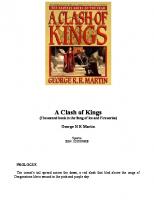
- Author / Uploaded
- Lisa Sabbage
Kings and Queens of England
©2004 Published Printed Designed TopPublishing All pictures ©2004 TopFoto unless specified. Cover: Detail of “God Sav
3,440 221 3MB
Pages 20 Page size 595.276 x 841.89 pts (A4) Year 2004
Recommend Papers
File loading please wait...
Citation preview
KINGS AND QUEENS OF ENGLAND
©2004 Published Printed Designed TopPublishing All pictures ©2004 TopFoto unless specified. Cover: Detail of “God Save the Queen”, British Railways (Western Region) poster produced as a tribute to Queen Elizabeth II on the occasion of her coronation in 1953 by artist, Charles Shepherd. ©National Railway Museum / HIP / TopFoto
Back cover: The crown of Queen Mary of Modena, c1685. Wife of King James II. ©Museum of London / HIP / TopFoto
Contents page (clockwise from top left): Tintagel Castle, Cornwall, Dark Ages. Tintagel Castle was the legendary birthplace of King Arthur. ©English Heritage / HIP / TopFoto
Part of The 120ft canvas, painted by Richard Barrett Davies depicting the Coronation Procession to Westminster Abbey of King William IV. ©PA / TopFoto
King George VI with his elder daughter, the future Queen Elizabeth II, 13 December 1936. The royal seal of King Edward II. Henry VIII’s pavilion at the Field of the Cloth of Gold, 1520. ©The British Library / HIP / TopFoto
12th Century King, probably King Richard I The Coronation Chair containing the Stone of Scone.
CONTENTS Introduction Roman Rule The Dark Ages The Anglo Saxons - Bretwalda Kings The Anglo Saxons - Kings of Wessex & England The Normans The Angevins The Plantagenets The Lancastrians The Yorkists The Tudors The Stuarts The Hanoverians The Windsors
Introduction A
dultery, murder, and regicide, civil war, religious upheaval and abdication – the kings and queens of England have certainly written a dramatic and intriguing history for their subjects. From 60AD, when the courageous Boudicca led the Celtic Iceni in a doomed revolt against the invading Roman army, through Roman rule and the arrival of William the Conqueror in 1066, to the mysterious death of Princess Diana in 1997, there has rarely been a dull moment for England’s rulers. Indeed, when not battling foreign forces they seemed to fill the time by fighting each other. Willliam’s death in 1087, for instance, lifted the lid on the sibling rivalry between his third and favourite son William Rufus, whom he named as his successor to the English throne, and his eldest son Robert, who had to make do with Normandy. Poor Robert led several uprisings against his brother before giving up and embarking on the Crusades. Then, on William II’s Queen Boudicca. death in 1100, it was their youngest brother Henry who seized the throne, leaving Robert out in the cold once more. It didn’t get any easier for the Plantagenets. In the 12th century, Henry II spent the final few years of his reign in open warfare with his rebellious sons, while 14-year-old Edward III, crowned in 1327, had to contend with the influence of his mother and her lover Roger Mortimer, an outbreak of the Black Death, and the beginning of the Hundred Years War with France. Edward’s grandson and successor fared even worse. Although he managed to rule for 22 years and dealt ably enough with the Peasants’ Revolt in 1381, Richard II never resolved his differences with his rebellious cousin Henry, who eventually forced his abdication and death in Pontefract Castle in 1399. No one knows whether Richard II died of natural causes or was murdered. But he was certainly not the last English king to suffer a mysterious fate. The plague of 1348 In April, 1483, 12-year-old Edward V became King of England. Unfortunately for the young king, his uncle was appointed as his Protector. Although charged with guiding the boy until he was old enough to rule on his own, Uncle Richard had very different plans for the throne. Richard seized Edward and executed his companions, insisting that he had acted only to thwart the influence of the boy’s maternal family. Then he declared that the boy was illegitimate. In June, having thrown Edward and his younger brother into the Tower of London, the putative Protector declared himself Richard III, King of England. Soon afterwards, Richard’s young nephews disappeared, probably murdered by the usurper or his Robert Mortimer agents. © The British Library / HIP / TopFoto Two years later, Richard III got his comeuppance when he
was killed during the Battle of Bosworth, the final battle of the Wars of the Roses between the rival royal families of Lancaster and York. As Richard’s successor, King Henry VII began the Tudor reign of England that would see his son Henry VIII execute two of his six wives and break with the Catholic Church in his desperate quest for a male heir. If King Henry VIII’s sanity was sometimes questioned during his turbulent 42-year reign from 1509 to 1547, plenty of other English sovereigns have raised concerns among their courtiers and subjects. In the 17th century, King James I was known as the “wisest fool in Christendom”, while the ineptness of his son Charles I led to a confrontation with the House of Commons that would result in Civil War and his own execution for treason in 1649. James’s great grandson King George I was a German who came to the throne in 1714 only because he was a Protestant. He could not speak a word of English and was so uninterested in the Satirical cartoon showing the public support for Queen affairs of the nation Caroline c.1820 that he gladly left ©The National Archives / HIP / TopFoto them to his ministers. It was largely thanks to his indifference that the system of Cabinet government under a Prime Minister evolved. Fifty-odd years later, King George III famously went mad (in fact he was suffering from a condition known as porphyria). Still, even he was more popular than his son and successor King George IV, who was widely condemned for his licentious and extravagant lifestyle. An indiscreet philanderer, his affairs were as well-reported as they were numerous, and his 1820 attempt to divorce his put-upon wife Caroline of Brunswick turned the disapproving public against him. When he was not preoccupied with women or his latest grand building schemes, George IV was thinking about clothes. His vanity was such that even his friend, the The Duke (formerly King Edward VIII) and Duchess of Duchess of Devonshire admitted that he “is fond of dress Windsor, 1940. even to a tawdry degree”. Sadly, his considerable appetite ©AP/TopFoto for rich food made him both fat and an easy target for the press, who published cartoons of the “Grand Entertainment” he had become. Ironically, George IV’s relationship with the media anticipated today’s tension between the monarchy and the fourth estate. Indeed, the Windsors have tried to learn from his misplaced efforts to woo the public, carefully managing the abdication of King Edward VIII in 1936 and, rather less successfully, the divorce of Prince Charles and Princes Diana. History, it seems, really does repeat itself. Fortunately for us, the history of England’s kings and queens is as colourful as it is long. The wedding of Prince Charles and Lady Diana Spencer, 1981.
©2004 Text by Lisa Sabbage
©PA/TopFoto
Notable Romans 43 - 54 Claudius
Roman Rule
Emperor 77 - 84 Agricola Governor 117 - 138
Left: The victory of Constantine the Great of Maxentius at the Milvian Bridge. Detail from the Fresco of Giulio Romano, Vatican ©Charles Walker / TopFoto
Hadrian Emperor
Right: Agricola
138 - 161 Atonius Pius Emperor 193 - 211 Septimius Severus Emperor 260 - 274 Marcus Postumus; Tetricus
Honorius who told Britons in 410 “Defend yourselves”.
Breakaway Emperors
Left: Honorius.
286 - 296
Middle Left: Gold aureus consecration coin of Septimius Severus. ©The British Museum/HIP/TopFoto
Carausius; Allectus Breakaway Emperors 306 - 337 Constantine I (the Great) Emperor 364 - 375 Magnus Maximus Breakaway Emperor 395 - 410 Honorius Western Emperor
Bottom Left: Hadrian’s Wall, near Walltown Crags. ©Woodmansterne/TopFoto
Bottom Right: Boudicca. who ruled the Celtic Iceni against the Romans.
The Dark Ages
Notable Kings 450 - 850 c.490 - 500 Ambrosius Aurelianus
c.540 Constantine King of Dumnonia 577 Condidan: Conmail: Farinmail All killed at Battle of Dyrham 590 Urien King of Rheged (Cumbria) 633 Cadwallon King of Gwynedd 642 Top Left: Map of Britain. 593 AD. Top Right: Gospel of St Luke, Lindisfarne Gospels. ©The British Library/HIP/TopFoto
Right: The death of Arthur. ©The British Library/HIP/TopFoto
Bottom Left: The Holy Grail appearing in a vision before King Arthur‘s Company. Bottom Right: Emblem of Sir Owen son of Urien.
Owen King of Strathclyde 750 Teudubr King of Strathclyde 844 - 872 Merfyn King of Gwynedd
Bretwalda Kings 449 Hengest and Horsa c.477 - c.491
The Anglo Saxons
AElle: King of Sussex c.560 - 93 Ceawlin: King of Wessex c560 - 616 Aethelbert: King of Kent (Died c.627) Raedwald: King of East Anglia 616 - 33 Edwin: King of Northumbria 633 - 55 Penda: King of Mercia 634 - 42 Oswald: King of Northumbria 642 - 70 Oswy: King of Northumbria 685 - 705 Aldfrith: King of Northumbria 688 - 726 Ine: King of Wessex 716 - 57 Aethelbald: King of Mercia 757 - 96 Offa: King of Mercia
Above: Saint Augustine of Canterbury (d.604) preaching before Aethelbert. ©ARPL/TopFoto
Far left: King Edwin of Northumbria, the first Bretwalda. Stained glass window in York Minister. ©Woodmansterne/TopFoto
Left: Offa’s Dyke. Below: King Offa sails to Saxony. ©The British Library/HIP/TopFoto
The Anglo Saxons
Kings of Wessex & England 802 - 58 Egbert 856 - 860 Ethelbald 860 - 866 Ethelberht 866 - 871 Ethelred 871 - 899 Alfred 899 - 924 Edward the Elder 924 - 939 Athelstan 939 - 946 Edmund I 946 - 955 Edred 955 - 959 Edwy 959 - 975 Edgar 975 - 979
Top Left: Bayeux Tapestry, King Edward The Confessor and King Harold. Top Right: King Alfred the Great statue in Worthing. Above Left: Athelstan. Above Right: The barge of Edgar King of England. Left: Ethelred II, The Unready. Bottom Left: Edmund Ironside. Bottom Right: Canute I.
Edward the Martyr 979 - 1016 Ethelred II the Unready 1016 April - November Edmund II Ironside 1016 - 1035 Canute 1035 - 1040 Harold Harefoot 1040-1042 Hardicanute 1042 - 1066 Edward the Confessor 1066 January - October Harold II
The Normans 1066 - 1087 William I (the Conqueror) 1087 - 1100
The Normans
William II 1100 - 1135 Henry I 1135 - 1154 Stephen
Top: Henry I sails for England. From Chronicle of Florence of Worcester c.1130-40.. Left: Stephen. Right: King Henry I.
©The British Library/HIP/TopFoto
Bottom Left: King William I accompanied by knights and soldiers, 14th century. Page of illustrated Latin text showing William the Conqueror riding a horse bearing his coat of arms of three gold lions on a red ground. ©The British Library/HIP/TopFoto
Bottom Right: Portrait of William II. Otherwise known as Rufus, apparently because of his ruddy complexion. From “Historia Anglorum” by Matthew Paris. ©The British Library/HIP/TopFoto
The Angevins
The Angevins
1154 - 1189 Henry II 1189 - 1199 Richard I 1199 - 1216 John
Top Left: Henry II at Waterford. Above: Richard the Lionheart, statue by Marochetti, Westminster. Left: King John hunting.
©The British Library/HIP/TopFoto
Right: King John signing the Magna Carta at Runnymede. 1215. Bottom: Kings of England, 14th century. Above: King Henry II and Richard I. Below: King John and King Henry III. ©The British Library/HIP/TopFoto
The Plantagents
The Plantagenets
1216 - 1272 Henry III 1272 - 1307 Edward I 1307 - 1327 Edward II 1327 - 1377 Edward III 1377 - 1399 Richard II
Top Left: Effigy of King Henry III on his tomb in Westminster Abbey. Top Right: King Henry III with a representation of Westminister Abbey. ©The British Library/HIP/TopFoto
Left: King Edward III depicted on the wall of St. Stephen’s Chapel, Westminster. Right: King Richard II. A painting in Westminster Abbey.
Left: Coronation of Edward I. Bottom: Tomb of Edward II, Gloucester Cathedral. ©English Heritage/HIP/TopFoto
The Lancastrians
The Lancastrians
1399 - 1413 Henry IV 1413 - 1422 Henry V 1422 - 1461 & 1470 - 1471 Henry VI
Top Left: Hoccleve Presents his Book to Prince Henry V. ©The British Library/HIP/TopFoto
Top Right: Coronation of Henry lV, 1399. ©The British Library/HIP/TopFoto
Bottom Left: King Henry VI and his wife Margaret of Anjou. Bottom Right: Henry IV, King of England from 1399. The son of John of Gaunt.
The Yorkists 1461 - 1470 & 1471 - 1483 Edward IV 1483 Edward V 1483 - 1485 Richard III
Top Left: Richard III and Queen Anne.
Top Right: King Edward IV.
Bottom Left: Richard III at the Battle of Bosworth.
Bottom Right: The Princes in the Tower. Duke of York and King Edward V.
The Yorkists
The Tudors
The Tudors
1485 - 1509 Henry VII 1509 - 1547 Henry VIII 1547 - 1553 Edward VI 1553 - 1558 Mary I 1558 - 1603 Elizabeth I
Top Left: Portrait of Henry VIII by Holbein at Belvoir Castle. Top Right: Henry VII holding a Tudor rose. Right: Edward VI.
©Corporation of London/HIP/TopFoto
Bottom Left: Queen Mary. Bottom Right: Queen Elizabeth I by M. Geerarts. Woburn Abbey.
The Stuarts
The Stuarts
1603 - 1625 James I of England 1625 - 1649 (executed) Charles I 1649 - 1685 Charles II 1685 - 1688 (Died 1701) James II 1689 - 1702 William III 1702 - 1714 Anne
Top Left: Queen Anne Top Right: Charles II Left: James VI of Scotland and I of England and Great Britain. Right: Successors to the throne abandoned by James II were his daughter Mary II and her husband William of Orange. Bottom Left: Portrait of Charles I as a Martyr King ©Museum of London/HIP/TopFoto
Bottom Centre: William III Bottom Right: King James II ©The British Library/HIP/TopFoto
The Hanoverians
The Hanoverians
1714 - 1727 George I 1727 - 1760 George II 1760 - 1820 George III 1820 - 1830 George IV 1830 - 1837 William IV 1837 - 1901 Queen Victoria
Top Left: King George II by Robert Edge Pine Top Centre: The Duke of Clarence, later William IV, the “Sailor King”. Top Right: George IV 1762-1830 King of Great Britain, Ireland and of Hanover. Right: George I ©Corporation of London/HIP/TopFoto
Bottom Left: Queen Victoria. Bottom Right: George III, by Allan Ramsey.
The Saxe-Coberg Gothas 1901 - 1910 Edward VII 1910 - 1936
The Saxe-Coberg Gothas
George V
Top Left: King George V making his Christmas broadcast in 1934. Top Right: King George V skippering his yacht Britannia. Bottom Left: Coronation photograph of George V and Queen Mary, 1911. ©Museum of London/HIP/TopFoto
Bottom Right: King Edward VII.
The Windsors
The Windsors
1936 (Abdicated, died 1972) Edward VIII 1936 - 1952 George VI 1952 Queen Elizabeth II
Top Left: Queen Elizabeth II visits Kingston-Upon-Thames in her Golden Jubilee year. ©National Pictures/TopFoto
Top Right: Coronation portrait of George VI, 1937. Bottom Left: Edward VIII and Mrs Simpson sightseeing at Tregir near Split 1936, the year Edward VIII abdicated to marry the divorcee, Mrs Simpson. Bottom Right: Queen Elizabeth II with heirs to the throne, Prince Charles, Prince William and Prince Harry. ©PA/TopFoto









